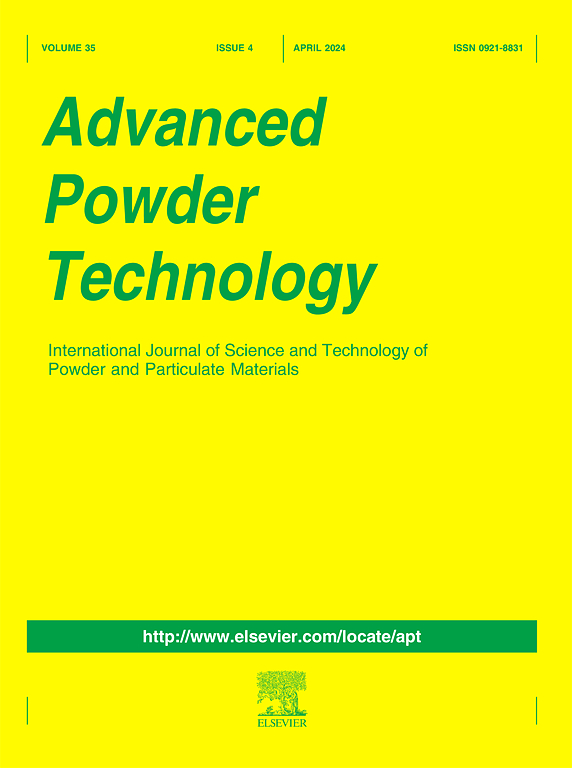Analysis of ball mill grinding kinetics for materials with uncommon breakage characteristics
IF 4.2
2区 工程技术
Q2 ENGINEERING, CHEMICAL
引用次数: 0
Abstract
Generally, a specific breakage rate function of power-law type and a breakage distribution function that is a weighted sum of two Gaudin-Schumann distributions are adequate for characterizing the breakage properties of materials. In such cases, after a certain period of grinding, a self-similar size distribution regime develops, where the particle size distributions collapse onto a single curve when plotted using particle size scaled by the mean size. The Kapur mean particle size-grinding time relationship is valid in this regime. However, in the case of two samples of dolomite and hematite, the above-mentioned functional form for the breakage distribution function gave a negative value for the fraction reporting to the next finer size interval. After trying several different functional forms, we used a weighted difference of two Gaudin-Schumann distributions instead of the sum. This approach gave good results. It was found that the breakage distribution function curves were concave downwards instead of concave upwards as is generally the case, a relatively small fraction of the broken material reported to the next finer size interval, and the specific breakage rate function was particle size independent. The Kapur mean size-grinding time relationship was valid in the self-similar size distribution regime, and it supported the size independence of the specific breakage rate function. However, the particle size scale factor was not the mean size. It was the mean size squared for dolomite and the mean size cube for hematite. Simulated size distribution data showed that the particle size scale factor varies with the material breakage characteristics.

特殊破碎特性物料的球磨机粉碎动力学分析
一般来说,幂律型的特定破损率函数和两个高丁-舒曼分布的加权和的破损分布函数足以表征材料的破损特性。在这种情况下,经过一段时间的研磨,形成一种自相似的粒度分布制度,当使用平均粒度缩放的粒度绘制时,粒度分布崩溃到一条曲线上。Kapur平均粒度-磨矿时间关系在此范围内是有效的。然而,对于白云石和赤铁矿两种样品,上述破碎分布函数的函数形式对报告下一个更细粒度区间的分数给出了负值。在尝试了几种不同的函数形式后,我们使用两个Gaudin-Schumann分布的加权差来代替和。这种方法取得了很好的效果。研究发现,破碎分布函数曲线是向下凹的,而不是一般情况下向上凹的,破碎物料报告到下一个更细粒度区间的比例较小,比破碎率函数与粒度无关。Kapur平均粒度-磨矿时间关系在自相似粒度分布条件下成立,支持比破碎率函数的粒度独立性。然而,粒径尺度因子并不是平均粒径。这是白云石的平均尺寸的平方和赤铁矿的平均尺寸的立方。模拟粒度分布数据表明,粒度尺度因子随物料破碎特性的变化而变化。
本文章由计算机程序翻译,如有差异,请以英文原文为准。
求助全文
约1分钟内获得全文
求助全文
来源期刊

Advanced Powder Technology
工程技术-工程:化工
CiteScore
9.50
自引率
7.70%
发文量
424
审稿时长
55 days
期刊介绍:
The aim of Advanced Powder Technology is to meet the demand for an international journal that integrates all aspects of science and technology research on powder and particulate materials. The journal fulfills this purpose by publishing original research papers, rapid communications, reviews, and translated articles by prominent researchers worldwide.
The editorial work of Advanced Powder Technology, which was founded as the International Journal of the Society of Powder Technology, Japan, is now shared by distinguished board members, who operate in a unique framework designed to respond to the increasing global demand for articles on not only powder and particles, but also on various materials produced from them.
Advanced Powder Technology covers various areas, but a discussion of powder and particles is required in articles. Topics include: Production of powder and particulate materials in gases and liquids(nanoparticles, fine ceramics, pharmaceuticals, novel functional materials, etc.); Aerosol and colloidal processing; Powder and particle characterization; Dynamics and phenomena; Calculation and simulation (CFD, DEM, Monte Carlo method, population balance, etc.); Measurement and control of powder processes; Particle modification; Comminution; Powder handling and operations (storage, transport, granulation, separation, fluidization, etc.)
 求助内容:
求助内容: 应助结果提醒方式:
应助结果提醒方式:


